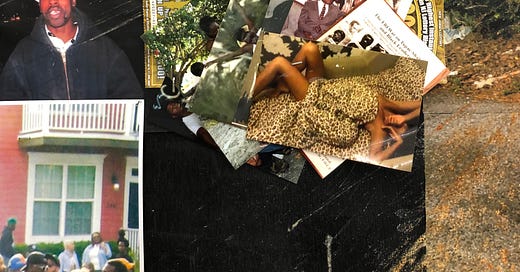REVIEW: in the whirlwind or in the storm
Sanctuary containing Passiflora, cash, hot sauce, Vaseline, cocoa butter, concrete, Obamas, Stanley Tumblers, and Taylor Swift merch
Adrian Piper decided not to participate in all-Black shows. This is something I think about a lot in relation to how artists today might strategize to develop institutionally enticing narratives while avoiding being pigeonholed. With this in mind, I approached this exhibition with both curiosity and a bit of apprehension, particularly because the promo image of the three residency artists seemed to highlight a DEIA-approved selection of Hispanic, Asian, and Black artists. I wonder if my reaction is influenced by my recent reflections after watching American Fiction.
I anticipated legible and exhausted narratives of racial struggles, but the artists managed to deviate from these expectations—though not entirely. While their works respond to the curatorial focus of “sanctuary,” this theme wasn’t immediately obvious to me, even after reading the press release. However, this lack of clarity didn’t detract from the exhibition’s effectiveness as a group show, even with just eight works on view. In fact, I would argue that thoughtful and focused exhibitions shouldn’t require more than that. I don’t think I derive much value from being inundated with hundreds of works in one massive institutional space, other than incidental exercise.
Race-based identity politics is most apparent in Oji Haynes’s works, which include collages of the Obamas and images of Black people and culture photographed by the artist. One installation features a fat pile of cash, meant to draw a connection between Black lives, capitalism, and exploitation. Sure, capitalism impacts races differently, but it is not a uniquely Black problem, so I wanted to see more aesthetically focused messaging around the tension between Black lives and capital. Another work is a rug coated in hot sauce, Vaseline, cocoa butter, concrete, and other materials. It apparently builds on the grammar of Abstract Expressionism, and the painterliness is visible. That’s a great way to align the work with a familiar art historical lineage while also mocking the elitism constructed around haphazard aesthetics (dare I say). Also, isn’t identity politics essentially an abstract expression?
While Oji Haynes’s work confronts the intersection of race and capitalism through a direct, almost confrontational lens, Cielo Félix-Hernández’s approach is more introspective, using the materiality of wax and flora to explore identity through the subtle interplay of body and nature. Cielo Félix-Hernández’s wax sculptures are dyed with Passiflora, the flower of passionfruit. I appreciate the labor that went into it and the material connection to the flora of Puerto Rico, where the artist was born. The Passiflora also reflects the artist’s relationship to her own body as a Puerto Rican transwoman. I didn’t immediately connect with some of her works—paintings of Betty Boop and the Powerpuff Girls—but that’s probably because I generally feel distant from paintings and pop culture references. I respect that the artist grounds her exploration of identity in deeply personal and cultural symbols, but more could have been done for the messaging to be translated formally.
Alexander Si takes a more detached, almost satirical approach, using everyday consumer products to critique the commodification of culture in a hyper-capitalist society. I first encountered his work a few years ago, when he didn’t explicitly address his race or ethnicity, and that remained the case for this exhibition. One of his works in the show is a terrarium tank that mimics a desert environment, containing shredded or broken pieces of Taylor Swift vinyls and merchandise, SKIMS shapewear, SKKN by Kim, and Stanley Tumblers. This time-based piece alludes to accelerationism, examining how these hyper-capitalist commodities become debris in a desert system. The future of this installation remains uncertain after the exhibition, but I hope Si finds a home for it so we can witness the further disintegration of these commodities over time.
I always have to wonder if exhibitions are extracting political relevance by checking off certain boxes and instrumentalizing the identities of artists who check off certain gender, race, and class boxes. It’s concerning to see contemporary exhibitions marketed more with edgy portraits of the artists than with the substance of their creations, as if their identity alone is the art. This trend feels like a troubling shift away from the intrinsic value of the art itself. The exhibition title, In the Whirlwind or in the Storm, borrowed from Marcus Garvey, evokes a vision of collective emancipation. Yet, as the exhibition text ponders the possibility of a sanctuary that offers care, agency, and freedom for all, the works on display suggest a more complex reality. The three artists reveal that sanctuary is not a one-size-fits-all concept. For some, liberation is found in the unfiltered expression of the intersections of their race, ethnicity, and gender; for others, it lies in the freedom to move beyond these markers entirely. This duality challenges us to reconsider the ways we understand and represent identity, urging a more nuanced approach that honors the individuality of each artist rather than subsuming them into broad, institutional narratives.
Cielo Félix-Hernández, Oji Haynes, and Alexander Si
in the whirlwind or in the storm: Abrons Arts Center’s Visual Artist AIRspace Resident Exhibition 2023–24
Hosted at Cuchifritos Gallery + Project Space
88 Essex St [inside Essex Market], New York, NY 10002
June 21–August 31, 2024
Hours: Wednesday through Saturday, 12–6pm



